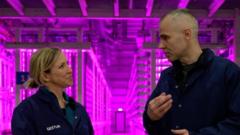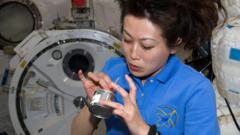Nestled beside Iceland's largest geothermal power station lies a state-of-the-art facility operated by Vaxa Technologies. Under an ethereal pink and purple glow, this indoor farm cultivates microalgae, a food source gaining recognition for its sustainability and nutritional benefits. General Manager Kristinn Haflidason leads visitors through this eccentric space, explaining how Vaxa harnesses geothermal energy to fuel its innovative farming methods.
Historically, while seaweed has been a staple in diets globally, its microscopic cousin, microalgae, has gone largely unexplored as a food source in modern cuisine. With roots in ancient civilizations, microalgae is now attracting attention from scientists and entrepreneurs for its potential to provide a sustainable, nutrient-rich dietary option. Located approximately 35 minutes from Reykjavik, Vaxa primarily produces Nannochloropsis microalgae, which is used both as food for humans and as feed in aquaculture, as well as Arthrospira, commonly known as spirulina.
The process employed by Vaxa captures carbon emissions while producing food, which contributes to its reputation as a carbon-negative operation. “The algae is eating CO2, or turning the CO2 into biomass,” explains Haflidason. This facility is innovatively integrated with the geothermal power plant, drawing on its clean electricity, low-temperature water, and a consistent CO2 supply—features that most algae farms don’t have access to.
Environmental experts, like Asger Munch Smidt-Jensen from the Danish Technology Institute, laud Vaxa's unique integration as a model for sustainable food production: “You have to artificially simulate the sun, so you need a high energy light source, but the low carbon footprint of this operation is commendable.” The technology behind this growth is enhanced by machine learning algorithms that optimize conditions for microalgae, and around 7% of the crop is harvested daily, accumulating to an impressive 150 metric tons annually.
Despite the trends that show increasing interest in microalgae—projected to be a market worth $25.4 billion by 2033—there remain hurdles to overcome before they can become a mainstream food. Algae's flavor and texture are still a work in progress. The challenge lies in making the eating experience enjoyable, as many potential consumers view these products with skepticism. The current recommendations involve incorporating microalgae into foods like pasta and bread to enhance their nutritional value without overwhelming taste.
The journey of making microalgae more palatable will be crucial for its acceptance in everyday diets. While its potential for mass production shows promise, experts urge further research into consumer acceptance and the sensory qualities of the products. Still, the global potential for microalgae as a sustainable food source remains promising—a future where integrating these organisms into our diets could significantly reduce land use and meet existing food demands.
As another visiting journalist experiences the harvested microalgae firsthand, they note its neutral flavor and soft texture reminiscent of tofu, suggesting that future processing techniques will play a critical role in how this ingredient can blend seamlessly into modern meals. Vaxa Technologies is not only changing how food is produced but also paving the way for innovative, eco-friendly alternatives in our diet.





















